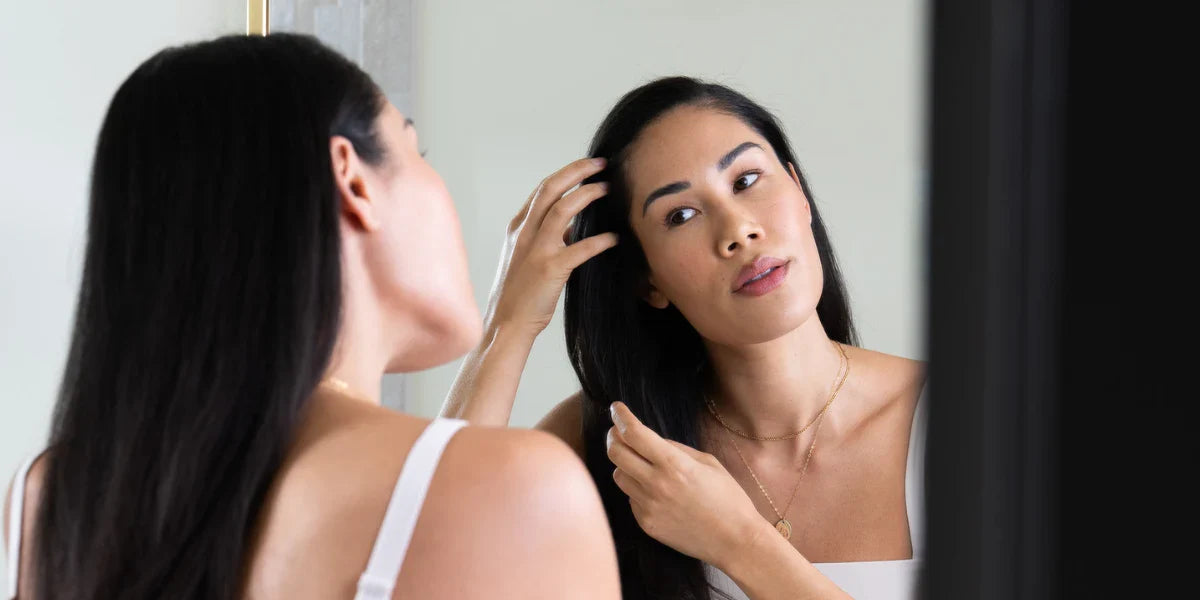At XYON, we often get questions from our patients about the difference between male and female pattern hair loss and specifically, whether female pattern hair loss is reversible.
Androgenetic alopecia is the clinical name for pattern hair loss and can apply to both men and women. But it’s been proposed that male pattern baldness and female pattern baldness are two distinct hair loss conditions, with the crucial difference being the role of androgen hormones in its development. What could these differences mean for the treatment of female pattern baldness and hair regrowth for women?
Is male or female pattern baldness more common?
Exact numbers for the incidence of pattern hair loss are difficult to pin down—that’s how common it is. But in general, epidemiological studies estimate that about 50% of men are affected by some degree of pattern hair loss by the time they hit 50. The incidence is slightly lower in women, coming in at about 25% by the same decade of life (Dinh and Sinclair, 2007).
Although it’s less common than male pattern hair loss, female pattern hair loss is the most common type of hair loss among women. The fact that it increases in frequency when women reach the end of their reproductive years tells us something about the possible causes. It’s believed to be partially driven by changes in hormone levels around and during menopause (specifically the balance between estrogen and testosterone), but this is just part of the story. Hair loss in women can be caused by many different factors, including environmental factors and inflammation and these can make diagnosis of pattern hair loss and treatment, challenging.
Is female pattern hair loss reversible?
Many women worry about whether their hair loss is permanent. Fortunately, in cases where the condition is correctly identified early on, female pattern hair loss can be reversible.
In her practice, board-certified dermatologist Dr. Christina Han encourages her patients to disclose as much information as is comfortable for them to help with diagnosis:
“Talking to your doctor about your hair loss history is an important first step to delineating possible causes. Onset, rapidity of hair loss, as well as family and dietary history are all potentially important clues. When I diagnose my patients, I also ask about general medical history and any medications she may be using. When I consider all these pieces of information, it becomes easier to separate pattern hair loss from other conditions like telogen effluvium or alopecia areata (an autoimmune condition), that can mimic it.”
Female pattern hair loss: Key differences
Female pattern hair loss differs from male pattern hair loss in both its presentation and causes. Whereas men typically exhibit receding hairlines and bald spots at the very top of the head, thinning in women can be more subtle.
For instance, you may have heard of the term “Christmas tree pattern” being used to described female pattern hair loss. When hair is parted straight down the middle, thinning tends to be more prominent closer to the front of the hairline, on either side of the part. In other cases, women may notice that their hair is thinnest along the entire hairline.
In addition to looking different, there isn’t a single direct cause for female pattern hair loss. To put this in perspective, in most cases of male pattern hair loss, thinning develops when an individual has a heightened response to elevated levels of dihydrotestosterone (DHT). This response is determined by genetics and causes the hair follicles to undergo a process that renders them unable to produce healthy hair.
Although some women with pattern hair loss do exhibit higher levels of DHT and other precursor male sex steroid hormones, many have completely normal levels of these hormones. With the help of continuing research on women’s hair loss, scientists have discovered that genetics, hormones, environmental factors and lifestyle are all potential causes of female pattern hair loss. Many doctors, including the specialist physicians at XYON, are aware of the multifactorial nature of women’s hair loss and prepared to help support our patients through every step of the hair regrowth journey.
Treating male vs female pattern hair loss
Because of the complex nature of female pattern hair loss, treating it effectively can be challenging. Let’s talk about the pharmaceutical options first.
Medications that have been traditionally effective for male patients don’t necessarily work as well in women. This goes back the discussion earlier about how androgen hormones are a small piece in the greater picture of female hair loss.
What’s more, because medications like finasteride are potentially dangerous to fetal development, there is limited data on how useful and safe they are in women in their reproductive years. The data on finasteride and dutasteride shows that the efficacy of this type of medication often depends on the patient.
Dr. Han weighs in on the challenge that treating female pattern hair loss can pose:
“Unfortunately, women have fewer options when it comes to approved pharmaceutical treatment options for hair loss. Many physicians and dermatologists will prescribe these medications off-label to their patients on a case-by-case basis when the potential benefits outweigh the risks. Finasteride and dutasteride are two examples. These agents have not been formally approved by the FDA or Health Canada for the treatment of hair loss in women.
Another example is spironolactone, which is a type of pill called an anti-androgen. It’s used in dermatology at doses of 50-200mg to help with hair loss and acne. Oral minoxidil could also be an option, which women are typically prescribed at dosages of 0.5-2.5mg. Topical minoxidil is also a possibility and is available over-the-counter as a foam at a concentration of 5%.
We already spoke about finasteride and dutasteride above, but there are topical versions of these medications that can be prescribed as well. These options are readily used in male patients but could be considered in post-menopausal women. For many of these medications, it’s important that women are NOT considering pregnancy or are breastfeeding and should consult with a healthcare professional to determine which treatment(s) would be most appropriate in their case.”
Ultimately, the decision to treat hair loss with medications is up to the patient. Not all women will find that pharmaceutical options are right for them and that’s okay. It’s important for us to talk about what some of these alternatives might be.
“The strongest evidence for standalone therapy for the treatment of female hair loss is topical minoxidil. There is a large body of data that supports its ability to halt further hair follicle miniaturization and promote the regrowth of hair by prolonging the active growth phase of the hair cycle. Topical minoxidil could be used as a starting point for many patients, including those who aren’t ready to take oral medications. It can also be used as an adjunct to other treatments, including other non-medicated options or approaches to stimulating hair growth.
Although alternative treatments exist, the reality is that many non-prescription options simply don’t have the robust data or evidence to support their ability to regrow hair. However, they can certainly offer other benefits like improved hair strength, reduced scalp inflammation and flaking. These are all important elements for healthy hair growth. Think of hair products that contain ingredients like peptides, ketoconazole, saw palmetto and rosemary. These can be very useful when used as part of a multi-step or multi-product regimen for hair growth.”
Reversing female pattern hair loss: Takeaway
Until recently, female pattern baldness and male pattern baldness have been grouped as the same type of hair loss disorder. At XYON, we acknowledge that the causes underlying female hair loss are different and women experiencing hair loss could benefit from a more tailored approach to care. We encourage women to work closely with their healthcare providers from the time hair loss is noticed to ensure that the condition is correctly identified and treatment (if needed) is initiated. If you’re not sure where to start, you can take a look at our hair loss treatments for women, which have been selected and formulated to address multiple causes of hair loss.




